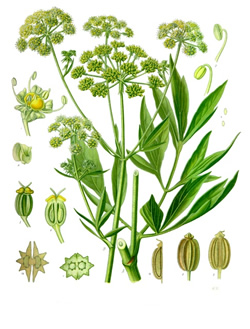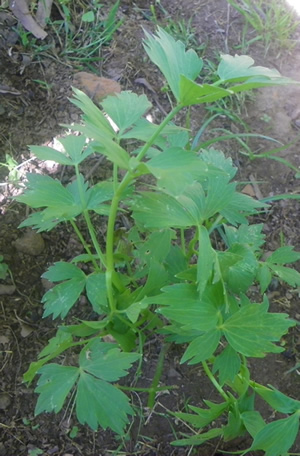Lovage Levisticum officinale

- Common Names
- Lovage
- Botanical Name
- Levisticum officinale
- Family
- APIACEAE
Medicinal Uses & Benefits of Lovage
![]() How to Use|
Side Effects |
Plant & Garden|
How to Use|
Side Effects |
Plant & Garden|
- Medicinal Uses: * Aromatherapy
* Culinary/Kitchen
- Properties: * Antispasmodic * Aromatic * Carminative * Diaphoretic * Diuretic * Emmenagogue * Nervine
- Parts Used: leaves, root, seeds
- Constituents: quercetin. the root also contains 1,8-cineole, camphor, coumarins, eugenol, limonene, and methol
How to Use: Lovage
Preparation Methods & Dosage : Fresh or dried Lovage leaves may be eaten as a vegetable, or used in soups and as a garnish, much like parsley. Also found in tinctures and extracts.
Lovage Side Effects: Lovage root contains furanocoumarins which can lead to photosensitivity.
Plant Description

immature plant in spring
- Flowers:Umbrel yellow flowers
- Plant Class:Perennial herb
- Leaves:Large, dark green, radical leaves, aromatic odor
- Root: Thick, fleshy, carrot-like
- Preferred Habitat:
- Flowering Season:June, July
- Distribution:Introduced to North America by English colonists, it now grows wild in New England, the Great Lakes states, Wyoming, Colorado, and New Mexico.
Regional Traditions :North America *
How to Grow Lovage
Plant these tall, leafy plants at the back of the garden where their 6 ft height will not be an issue. The leaves and seeds of this overgrown parsley-type plant are used for medicinal and culinary uses. Lovage is considered a "magic bullet" companion plant; much as borage helps protect almost all plants from pests, so lovage is thought to improve the health of almost all plants.











